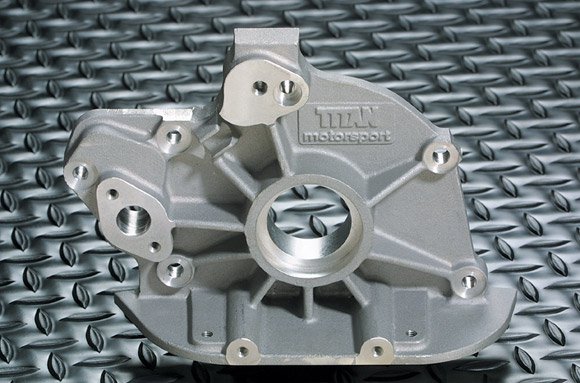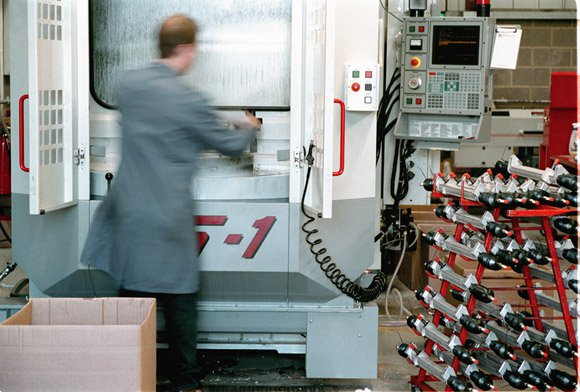From Motorsports Titan to First-Tier Supplier
To weekend racers and professional teams around the world, Titan Motorsport is a motor racing industry superstore. To the world’s automotive industry, it is a first-tier supplier of complex automotive systems. The gradual metamorphosis that transformed a motorsport job shop from a one-time builder of Formula Ford cars into a supplier of automotive systems owes much to the company’s investment in manufacturing technology, and its high standards of quality and reliability.
Based in St. Neots, Cambridgshire (UK), Titan’s stockroom is wall-to-wall shelves, where flywheels for Minis can be found next to sumps for Caterham 7s, parts for World Rally cars and gearbox housings for the latest Le Mans machines. It seems that whatever you need, in whatever formula, Titan either has it in stock or can make it, PDQ.
“We maintain a stock of all the more common items, because enthusiasts and teams can’t afford, and don’t want, to wait,” says Paul Littledyke, Titan’s General Manager. “We’ve made quick response our specialty, and our reputation and business have grown. We’ve never advertised and yet we get orders from all four corners of the globe.”

The company also holds a comprehensive stock of parts that are no longer made by the original manufacturer. “A car or an engine may have been discontinued by the original manufacturer, but that doesn’t mean everyone is going to stop using it,” states Littledyke. “We make parts for engines that have been out of production for a long time. If there is enough demand, if enough people are racing a particular engine or car, then we’ll make the parts and hold them in stock.”
Helping to build the company’s reputation for fast turnaround and consistently high quality are the 14 Haas CNC machines – vertical machining centres and lathes – which occupy the Titan machine shop.
“The Haas machines work well for us,” states Managing Director Oz Timms. “The reason why we have 14 of them is that they offer exceptional value for the money, and Haas UK does a great job of supporting them. It’s not like dealing with a big corporation. We can always talk to the right people and we get things done straight away. Despite the fact that we have so many machines, we don’t have that many issues. If we do, we know that Haas UK will get them sorted.
“Originally, Titan made entire racing cars and racing engines,” says Timms. “As time has gone by, we’ve expanded our spares product line, and we’ve developed an in-house design facility, as well. Our capabilities as a supplier have grown considerably, to the point now where not only can we receive and manufacture designs for the top F1, World Rally and Le Mans teams, but we can also design, manufacture and assemble many of the components used on these vehicles.” This capability has not gone unnoticed by the automotive companies themselves, and some of this “systems” work involves high-volume production machining.
“This kind of work can tie up the Haas machines for prolonged periods,” says Littledyke. “It’s had a knock-on effect with the quick turnaround jobs and, to meet our order book, we’ve had to work the Haas machines 24 hours a day.”
Titan tried subcontracting the quick turnaround jobs but, says Littledyke, “it caused more headaches than it cured.” The company risked letting its customers down and harming its hard-earned reputation.
Titan Motorsport had arrived at a fork in the road. “We had a simple choice,” says Timms. “We could stay the same, continuing as a pure motorsport supplier, or we could recognize this as an opportunity and expand to take advantage of it.”

“We wanted to be able to say: We can design it, we can prototype it and we can manufacture to production volumes. That’s what Titan Automotive is all about,” says Timms. “Titan Motorsport handles the fast turnaround one-offs and batch jobs, and Titan Automotive does the production work.”
Early in 2001, to move Titan Automotive up a gear, the company invested in another batch of Haas CNC machine tools: A VF-3 vertical machining centre with a Haas HRT 160-2 rotary table, and an HS-1RP horizontal machining centre. The Haas VF-3 has a 1219 mm (48″) long table and a Y travel of 508 mm (20″), making it ideal for long components. The HRT 160-2 is a compact rotary table with twin platters that allow two components to be loaded side by side.
“These latest machines,” explains Littledyke, “were introduced to machine a particular job: steering rack assemblies for the Lotus Elise sports cars. We asked Haas UK to propose a solution for the steering racks on a turnkey basis.”
Using Gantt charts and project management software, Haas UK began comprehensive project planning that included the scheduling of engineering resources and identifying and detailing the project costs. The HS-1RP was chosen as the basis for the project for a number of reasons, according to Haas UK Technical Director, Pat Fenn. “The HS-1RP lends itself well to this type of component. A vertical machining centre wouldn’t have allowed sufficient room underneath the spindle. We used manual clamping; since the machine has twin pallets, one is in cycle whilst the other is free for unload and load.”
Once the machine and the project parameters were established, Haas UK worked closely with external suppliers to choose tooling and design the most effective fixtures. These elements were included in the overall project and a proposal was presented to Titan.
When the project was complete, the customer was invited to the Haas Technical Centre in Leicester, where the job was proven and cycle times and quality were accepted and signed off. The machine was then shipped to Titan, installed, and the whole acceptance procedure was repeated before the machine was put into production.
The raw rack castings arrive from the foundry and are loaded in pairs onto the HRT 160-2 rotary table mounted on the Haas VF-3. The castings are skimmed, and two dowel holes are drilled.
The rack castings are then moved to the HS-1RP where, again, they are loaded in pairs onto the manual clamps located on the machine’s built-in, rotary-mounted pallet. The castings are faced and the end holes are bored. A batch of castings is completed and bushes are inserted in the rack ends. Pairs of castings from the batch are then remounted on the HS-1RP and are roller burnished.
Then, it’s back to the VF-3, where finishing operations – drilling, tapping and profiling – are carried out. Once all of the machining has been done, Titan builds the racks and ships complete systems to the Lotus production line at a rate of 600-800 a month.
“Machining of the racks used to be done on two Haas VF-0Es,” explains Littledyke. “Previously, a single rack would take 30 minutes on a smaller Haas vertical machining centre. We’ve reduced the cycle times considerably by installing the VF-3 with the twin rotary and the HS-1RP with its twin pallet changer and rotary table. But, that’s exactly what automotive work of this nature is all about. Where the motorsport work is all about fast turnaround, automotive production work is all about productivity – reducing cycle times, improving the process, reducing the cost. We’re under constant pressure from the client, and the Haas machines have to work very, very hard.”
Titan’s Haas VF-3 and HS-1RP are dedicated 90%-95% of the time to the Lotus work. “They handle the high-volume production work just as well as the 14 other Haas machines handle the quick turnaround motorsport jobs,” says Littledyke. “We’re delighted with the quality and the reliability.”
The Haas machines work well for us. The reason why we have 14 of them is that they offer exceptional value for the money, and Haas UK does a great job of supporting them. It’s not like dealing with a big corporation. We can always talk to the right people and we get things done straight away. Despite the fact that we have so many machines, we don’t have that many issues. If we do, we know that Haas UK will get them sorted.
Oz Timms, Managing Director




